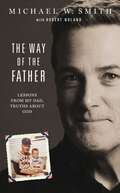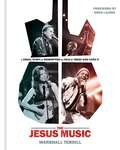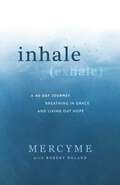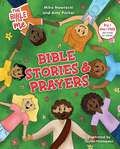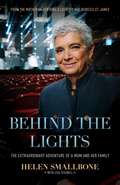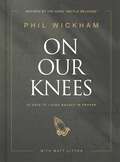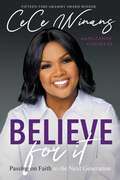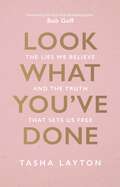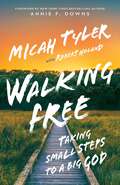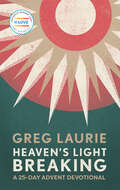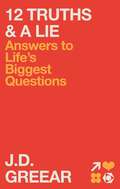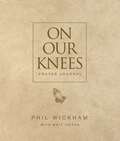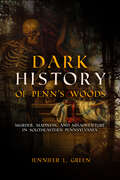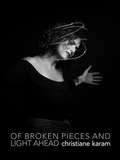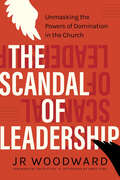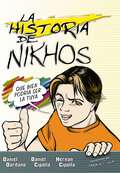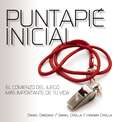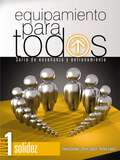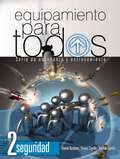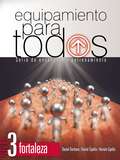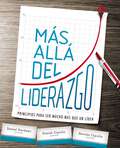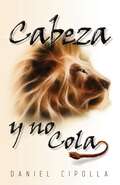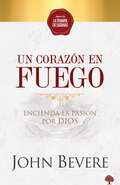- Table View
- List View
The Way of the Father: Lessons from My Dad, Truths about God
by Michael W. SmithGrammy Award winner Michael W. Smith&’s The Way of the Father offers a deeply personal reflection on his father Paul Smith&’s legacy and its profound effect on every area of his life. Through the life and lens of his earthly dad, the multi-platinum selling Christian artist gives glimpses of a Father in Heaven that anyone can approach and experience. Michael W. Smith, multi-platinum artist, celebrated songwriter, producer, best-selling author, and acclaimed actor, himself a father of five adult children and grandfather of sixteen, calls upon his humble experiences of growing up in a small West Virginia town to share his father&’s story. Each chapter identifies a quality and characteristic of his dad that came out of an obedient and sacrificial life, committed to serving his Abba Father, including: - Finding truth in tragedy - Loving unconditionally - Persevering through pain - Bringing righteousness to the world - Influencing and inspiring generations - Discovering identity and approval in Christ Paul Smith was a familiar face in the crowd at Michael W. Smith&’s concerts over the years. A kind and joyful man who would sing, dance, and worship to the singer&’s countless number one hits, with his countenance beaming brighter than the spotlights on the stage, Paul would often introduce himself to those nearby and talk about how proud he was of his son. From the artist&’s early days as a struggling musician in Nashville to his death in 2015 (the year his son&’s album sales surpassed 15 million), Paul was always Michael&’s biggest fan. Michael shares how his dad inspired and encouraged him using biblical principles and virtues. Now, Michael passes on these same truths through stories, testimonies, origins of songs, and personal insights from his family life and thirty-five plus years of touring as a Christian artist. He hopes that by sharing his father&’s legacy, readers will come to find that no matter who our earthly parents have been in our lives, our Abba Father will never fail us. The Way of the Father will likewise challenge readers in their faith journeys so they will one day hear, &“Well done, good and faithful servant. You have fought the good fight, run the race, and have been found faithful&”—just like Paul Smith heard on the day he was called home to be with his Father.
Smells Like Bacon: The Skit Guys Guide to Lifelong Friendships
by Eddie James Tommy WoodardThe guys who together form the popular comedy duo The Skit Guys, take their distinct brand of humor and apply it to a guide on how to make and keep friends and why it matters for a life of faith and laughs. Tommy Woodard and Eddie James, the men who form the widely popular comedy duo The Skit Guys, have been best friends since high school. With encouragement and guidance from their youth pastor, the guys started to write and perform skits for their youth group. Since their high-school days, they've been writing and performing hilarious and poignant skits live around the world and on camera, as well as on their site, SkitGuys.com. Everywhere they go, the question people always ask them is, &“How did you guys get to be and figure out how to stay friends?&” Now, this offbeat duo is coming together to present Smells Like Bacon: The Skit Guys Guide to Lifelong Friendships, a book about the power of friendships and how to build the kind of friendships that last. Written in the signature hilarity of a Skit Guys dialogue—with well-placed banter or two sprinkled in for good measure—Smells Like Bacon explores: - Who needs friends? - Let&’s-Dig-in-the-Dirt Friends - Awkward things not to say to potential friends - Crying at the movie Beaches - How to be a good friend; - What to look for in friends—and what to avoid; - How to handle difficult situations in friendship; and - Why God makes a great friend - And fun and random stories, and of course, bacon references Tommy and Eddie have traveled the world performing for families at events, churches, and conferences. Their SkitGuys.com website has grown into a treasured media resource for families, pastors and churches. Their numerous short films, skits, and scripts are used to reach families all over the world. When The Skit Guys aren't performing or shooting new short films, both Tommy and Eddie serve in their local churches, enjoy good food (especially pizza and fries!), and love life with their families.
The Jesus Music: A Visual Story of Redemption as Told by Those Who Lived It
by Marshall TerrillA written and visual complement to the documentary film of the same name, The Jesus Music brings the history of a movement to life. Featuring Contemporary Christian Music artists across five decades, readers will experience the story that has united and changed the lives of people around the world. The Jesus Music: A Visual Story of Redemption as Told by Those Who Lived It shares that story: people creating something they wanted, something that never existed before. Written by music and film historian Marshall Terrill, the book accompanies a documentary film by award-winning directors Jon and Andy Erwin; this written and visual narrative of the genre features historic concerts and candid behind-the-scenes photographs throughout. The Jesus Music explores the history, evolution, and redemptive thread of Contemporary Christian music over the last fifty years as it spans the convergence of rock and roll, country, and gospel music. As CCM grows, readers will see California artists as much a part of hippie culture as Christian culture, religious-focused bands and songs denounced by some church leaders of the day, and best-selling artists who rose, and sometimes fell from fame, as they journey through the music and experience the often delicate balances between faith, fame, mission, and humanity as they relate to Christian music. The notable voices of Amy Grant, Michael W. Smith, Kirk Franklin, and TobyMac, as well as the stories of dozens of additional Christian artists, will hit all the right notes and explore: - The roots of the movement, spanning from Elvis Presley and Johnny Cash to Switchfoot, Chris Tomlin, Hillsong United, and beyond. - The stories of pioneers in the genre, including Larry Norman, Lovesong, and Stryper - Insights into how history, culture, and technology shaped the Contemporary Christian music we hear on the radio today. - Examples of God&’s steadfast love as He uses artists despite their human mistakes and shortcomings. - How the message of the music transforms lives and has impact beyond artistic expression. The Jesus Music is perfect for anyone looking to explore the history of the genre and discover how God can use us despite our flaws to impact the world.
Inhale Exhale: A 40-Day Journey Breathing in Grace and Living Out Hope
by Robert Noland MercyMeA 40-day devotional experience inspired by MercyMe&’s best-selling album, inhale (exhale) follows the sixteen-track record to create a path for readers to breathe in and absorb God&’s grace in their lives. Inspired by MercyMe&’s album of the same name, inhale (exhale): A 40-Day Journey Breathing in Grace and Living Out Hope follows the sixteen-track record to create a path for readers to breathe in and absorb what God can do, and then release His spirit of grace by offering hope in the world. The heart of this devotional is found in two days of entries, an &“inhale&” day and an &“exhale&” day, designed to coincide with each song as readers work their way through the album and devotional. Each entry ties to a particular song and couples those thoughts and lyrics with scripture passages, application questions, meditative verses, prayers, and space to journal. These entries are: 1. Inhale 2. Blessed 3. On Our Way (Ft. Sam Wesley) 4. So Yesterday 5. A Little Love (Ft. Gary LeVox) 6. Whiplash 7. Bright Side of Broken 8. Let Yourself Be Loved 9. Hurry Up and Wait 10. Brand New (Ft. Gloria Gaynor) 11. Uh, Oh (Here I Go) 12. The Moment 13. Then Christ Came (Demo) 14. Say I Won&’t 15. Almost Home 16. Exhale Marking the twentieth anniversary of the band, after being named Billboard&’s Top Christian Artist of the Decade from 2010-2020, coupled with the breakout success of the 2018 film I Can Only Imagine, songwriter and lead singer Bart Millard said, &“Going to these dark places that you have to go to write, I didn&’t know how to make music that wasn&’t connected to something painful, especially when I associated that with the songs that mean the most to me. It&’s been hard to go to that place, but I love the results when I do. For the first time, with inhale (exhale) it was more about other people&’s stories than mine. I was writing out of something that I witnessed more than I experienced myself.&” This devotional helps readers to reflect on themes like: - Letting go of the past - Allowing God to teach you how to love yourself - Believing that when we are broken, hope is never far behind - Wrestling honestly in the battle between faith and doubt - Trusting Jesus through the chaos in this crazy world Readers will be challenged and encouraged on this 40-day journey with MercyMe as they meet with God, accepting His invitation to breathe in grace and live out hope.
The Bible for Me: Bible Stories and Prayers
by Mike Nawrocki Amy Parker Brentwood StudiosThe Bible for Me: Bible Stories and Prayers is a new Bible storybook and the first title in The Bible for Me brand of related products for kids ages 4-8 from the team at Brentwood Studios and authors Amy Parker and Mike Nawrocki. The 50 stories are written and designed to share the story of God's people and His love for each child, in a way that it is relevant and relatable to the reader. Each story ends with a prayer where the reader can easily insert the child's name, making the stories uniquely personal. The book features fresh, colorful illustrations from Taylor Thompson Lynch. This Bible storybook was written specifically to show God's love and purpose for each unique child, making it clear that these timeless stories are meant for each and every one of us, here and now, today.
Behind the Lights: The Extraordinary Adventure of a Mum and Her Family
by Rebecca St. James Lisa Stilwell Helen SmallboneFrom the Woman Who Inspired Unsung Hero—A Major Motion Picture In this inspiring debut memoir, Helen Smallbone, mother of seven creative children?including Christian music artists for KING & COUNTRY and Rebecca St. James?chronicles the family&’s journey of faith across the ocean to go where God was leading. Written from a mother&’s perspective, Helen shares stories of peaks, valleys, and a family trusting God for provision. Helen Smallbone&’s heartfelt story illustrates what it means to really let God lead, which almost always means living outside the box of how the world says to live. How did an ordinary Australian family produce two Grammy Award–winning artists?Rebecca St. James and for KING & COUNTRY? What happened to bring the Smallbones through closed doors and to new beginnings in the United States? In Behind the Lights, Helen shares not only these stories of her family but of the life lessons they all learned along the way. In 1991 Helen and her husband, David, packed up their family and sixteen suitcases to move from Australia to the United States. Completely isolated from the support of family and friends, they relied on God to provide them with hope and direction. Helen watched her children join forces as Rebecca St. James&’ career grew, soon followed by blossoming careers for the others?as artists, entrepreneurs, filmmakers?and the rise of Joel and Luke&’s for KING & COUNTRY on Christian music charts. Helen shares untold stories and insights into how her family worked and stuck together, constantly relying on their faith to guide the way. Helen&’s journey includes: - Meeting her future husband with a cockatoo on her shoulder - The family&’s move to the states in blind faith - The kindness of neighbors and the local church that gave them the encouragement they so desperately needed - Years of touring alongside Rebecca and the formation of for KING & COUNTRY - The ways God led and enabled her to homeschool and think about education differently - An inside look at the stories and dynamics of the entire Smallbone family No matter where you are in life, Helen shows through her own experiences that what God has done in her life, He will do in yours, too.
On Our Knees: 40 Days to Living Boldly in Prayer
by Matt Litton Phil WickhamRediscover the joy, power, and intimacy of prayer in On Our Knees, a forty-day devotional that illuminates the power of being with God-inspired by Dove Award-winning worship music artist Phil Wickham's hit song "Battle Belongs." Phil Wickham's On Our Knees: 40 Days to Living Boldly in Prayer explores biblical stories from Genesis to Revelation to learn about prayer from the heroes of our faith, including Moses, King David, and many more. How did these "heroes of the faith" pray? How did Jesus teach us to pray? Each entry in On Our Knees helps readers establish their own daily prayer routines, ultimately encouraging the lifelong practice of prayer as a means of connecting with and better understanding God. The devotional includes a suggested passage of scripture and Phil's reflections on the reading, a daily prayer and prayer practice to encourage spiritual growth, and a set of reflection questions to help the reader go deeper in his or her prayer journey. This devotional highlights: -Jesus's teachings on prayer -Prayer as the foundation for faith -Finding intimacy with God -Following God's path for our lives -Praying with boldness and courage, while also in humility and honesty -Letting go of anxiety and fear On Our Knees brings readers into a deeper intimacy with Jesus, encouraging a habit of prayer that can last a lifetime and cultivate a closer relationship with God.
Believe for It: Passing on Faith to the Next Generation
by CeCe Winans Suzanne GosselinFrom the best-selling female gospel artist of all time CeCe Winans comes a heartfelt guide full of spirit, music, and faith. CeCe's first book in over 10 years, Believe for It explores what it means to pass along wisdom and faith to generations to come. Believe for It: Passing on Faith to the Next Generation beautifully recounts the pivotal experiences in CeCe's life that have shaped her faith. From her childhood in Detroit and the miracle of motherhood to her award-winning music career, CeCe brings readers along for a story full of heart, passion, and wisdom acquired from her walk with God.The Grammy award-winning artist shares stories of her life and career and lessons she's learned along the way, including: - Growing up in a musical family with 9 siblings - Starting a church with her husband - Planting faith through the Word of God - Pushing through obstacles that prevent faith from being passed down - Fostering emotional health-mind, body, and spirit-in order to pour into others - What it means to be engaged in a community of faith - How to nurture the faith of younger generations Inspired by Generations-her popular show and conference-CeCe includes thoughtful questions at the end of each chapter to help readers foster their own intergenerational conversations. Full of heartfelt and profound teachings, Believe for It offers readers a glimpse into the life of legendary gospel singer CeCe Winans as well as an opportunity to grow in their own faith and wisdom as they pursue a closer relationship with the Lord.
Look What You've Done: The Lies We Believe & The Truth That Sets Us Free
by Tasha LaytonFrom Dove Award-nominated artist Tasha Layton, Look What You&’ve Done is a diverse collection of stories and intimate self-reflections to encourage readers to follow where God leads them. Inspired by her powerful song of the same title, Look What You&’ve Done delves into Tasha&’s journey of finding freedom in Jesus through life's twists and turns. Tasha takes readers through her early days in small town South Carolina, to her big breakthrough as background singer on stage with Katy Perry, to the mission field in Kenya and beyond. Across many countries and all her days, the truest constant in Tasha&’s life has been the presence of God in both the highs and the lows. As her inspirational stories reveal the ways God has guided her journey, Tasha also shares vulnerable reflections on the struggles she&’s faced in her life of faith and music. Readers will identify with Tasha as she describes the lies that she allowed herself to believe as she struggled with comparison, self-image, and the uncertainty of finding her purpose. Through challenges like these, God continues to bring Tasha wisdom and truth regarding who He is, and who she is meant to be. Look What You&’ve Done helps readers to: - Discern God&’s truth from the world&’s lies - Find freedom, truth, security, and identity in Jesus - Become increasingly bold in prayer - Live as a Christian in an uncertain world - See God&’s miracles in their life - Begin to embrace seasons of waiting Look What You&’ve Done: The Lies We Believe & The Truth That Sets Us Free will inspire you to walk in boldness and love, sharing the goodness of God revealed in your life.
Walking Free: Taking Small Steps to a Big God
by Robert Noland Micah TylerRenowned Christian music artist and former youth pastor Micah Tyler helps readers set out on the path to a free and meaningful life in his first book, Walking Free. Inspired by his hit song, Micah Tyler&’s Walking Free: Taking Small Steps to a Big God encourages believers to pursue a deeper relationship with Jesus, regardless of external circumstances. The journey from where we are to where God wants us to be is filled with challenges and obstacles. Walking Free uplifts readers with the truth that God will always walk with us and never leave us behind. Micah applies Scripture and Biblical wisdom in his teaching alongside personal stories which illuminate the path before us. With 45 steps, Walking Free includes questions and personal reflections that will inspire readers to grow in their relationship with God. Walking Free also includes: - A plan for pursuing God like never before - 42 steps covering many of life&’s challenges - Over 120 questions for self-reflection or discussion - Practical guidance for transforming your spiritual life - A glimpse into Micah Tyler&’s life and insights. Walking Free will help you overcome life&’s challenges by taking small steps to experience the mercy and mission of a closer connection with God.
Heaven's Light Breaking: A 25-Day Advent Devotional
by Greg LauriePrepare your heart for Christmas with Heaven's Light Breaking: a beautiful, giftable 25-day Advent devotional from beloved pastor and bestselling author Greg Laurie. This Christmas, take time each day to slow down and focus on the joy of the season. In Heaven&’s Light Breaking: A 25 Day Advent Devotional, best-selling author and pastor Greg Laurie shares wisdom, Scripture, and prayers designed to help you connect with God and find hope and peace amid the holiday rush. From the miracle of the virgin birth to the visit from the magi, Heaven's Light Breaking offers a fresh perspective on the most treasured days of the year. Each of Laurie's warm and engaging readings will uplift your spirit, inspire your thinking, and encourage you to savor the special nature of the Christmas season. Whether you read each day&’s devotional entry alone or with your loved ones, let the warmth and love of God's presence fill your heart and soul as you mindfully celebrate Christ&’s wondrous birth this advent.
12 Truths & a Lie: Answers to Life's Biggest Questions
by Troy Schmidt J.D. GreearLife is full of difficult questions and many of them often seem impossible to answer. In 12 Truths & a Lie, author and pastor J.D. Greear confidently tackles some of the most perplexing questions that Christians face. It&’s not unusual to have questions about life. In fact, many of us have the same questions. How do I know if I&’m going to Heaven? What&’s my purpose? Why isn&’t God answering my prayers? In his latest book 12 Truths & a Lie, author and pastor J.D. Greear offers scriptural insights and practical advice to help readers navigate life&’s toughest challenges. Unafraid to approach areas of doubt and uncertainty, Greear welcomes even the most challenging questions with curiosity, thoughtfulness, and scriptural application, leading readers into a more intimate relationship with Christ. 12 Truths & a Lie includes questions such as: - How could a good God send people to Hell? - How should Christians handle political differences? - Why does God care so much about my sex life? - Can I know that I&’m going to Heaven? - How do I know my purpose in life? Whether you&’re a new Christian or someone who has walked with God for a lifetime, 12 Truths & a Lie is an invaluable guide for readers seeking to deepen their understanding of God and explore how He meets us in the midst of our most soul-stirring questions.
On Our Knees Prayer Journal
by Matt Litton Phil WickhamInspired by Phil Wickham&’s bestselling 40-day devotional, the On Our Knees Prayer Journal is a thoughtful tool for anyone looking to actively deepen their prayer life. Track prayers, grow in this spiritual discipline, and reflect intentionally on daily Bible readings. Designed to help with guided prayer prompts users will record their thanksgivings, praises, and requests with plenty of space for capturing the details of their intimate time with God. Created to help individuals, this guide helps prayer journalers discover the power of prayer in their daily lives. With this journal, users will have the tools to: - Experience a meaningful intimacy with Jesus Develop stronger prayer habits - Let go of anxiety and fear - Discover and reflect upon God&’s Word – Lectio Divina - Approach God with humility, honesty, and vulnerability through prayer Face the challenges of life with steadfast habits of prayer and reflection. Whether partnered alongside Phil Wickham&’s 40-day devotional, On Our Knees: 40 Days to Living Boldly in Prayer, or used as a standalone resource, this journal provides users with a tangible place to record their spiritual journeys.
Dark History of Penn's Woods: Murder, Madness, and Misadventure in Southeastern Pennsylvania
by Jennifer L. Green<p>“Dark History of Penn’s Woods is the perfect book to keep you up all night… It’s ghostly, it’s ghastly, and we guarantee some of the included photos will stay with you!” — Philly Mag<p> <p>When ships under the command of white Europeans first sailed into the Delaware Bay in 1609, southeastern Pennsylvania's documented history of the strange and unusual began. This book tackles seven true "dark histories" from Chester and Delaware counties, which include tales of murder, witchcraft, cannibalism, tragic accidents and macabre events that actually happened in the Greater Philadelphia region. All stories are meticulously researched and placed within the greater context of Pennsylvania and world history. For example, the murder of three children by an indentured servant is placed within the context the kidnapping of children into servitude in England for sale to the Americas. The trial and execution of a woman for killing her infants is placed within the context of the rights of women in early America and how the court system failed them. The treatment of witchcraft is placed within the larger relationship of Quakers with the supernatural in Pennsylvania. This is not a book of ghost stories; this is an exploration of the real events that led people to believe in ghosts. It aims to strike a balance between a colloquial work that is accessible by a variety of readers, and an solid academic work.<p>
Of Broken Pieces and Light Ahead
by Christiane KaramOf Broken Pieces and Light Ahead is a compilation of prose and poetry that speaks to both our individual and shared human experience, of trauma, of healing and ultimately triumph. It is an exquisite yet profound portrayal of the winding and intertwining road that led the author from helplessness to empowerment, from fragmented to whole, and from darkness to light. It takes the reader on a journey through vivid snapshots of war, love, life and death, seen both through the lens of PTSD and from the perspective of someone who has overcome it.
The Scandal of Leadership: Unmasking the Powers of Domination in the Church
by Jr WoodwardThe fall of high-profile leaders has sadly become an epidemic, and although books and podcasts have sought to uncover the problem, they often fail to identify the root cause. In The Scandal of Leadership, JR Woodward offers a deeper diagnosis, outlining a more comprehensive understanding of power abuses in the church and the critical role of imitation. Drawing from Scripture and the scholarship of Walter Wink, René Girard, and William Stringfellow, as well as from positive examples of leaders such as Óscar Romero, this book offers a robust theology of the Powers--of Satan, the demonic, and the principalities and powers explored in the Bible. By unmasking the Powers of domination, Woodward seeks to help missional leaders practice a self-emptying spirituality that reshapes their desires and forms them into Christlike servants who join God's mission in the world.
King (Vegas Kings #2)
by Mckenna JamesAnyone but him. He’s a world famous Rockstar. A player.He’s also my brother’s best friend.King is selfish, arrogant, cocky. He’s everything I’m not.But when he walks into a room, it feels like it’s just the two of us,and when he kisses me—I forget all the reasons we shouldn’t be together.My friend Ellie says starting something with King would be a bad decision,But what if he and I are meant to be, and I don't give our love a chance?Wouldn’t that be even worse?Anyone but her. My best friend Jack has one rule; no messing around with his little sister.I can’t blame the guy. When it comes to breaking women's hearts, I’m the worst.But Piper has turned my world upside down, and I’m afraid it’s me who’s going to wind up getting hurt this time.She’s far too good for me, but when I’m with her, I start to believe I can be the man she deserves.People can change, right?I can change…Unless my best friend kills me first.
La historia de Nikhos: Que bien podria ser la tuya
by Daniel Dardano Daniel Cipolla Hernán Cipolla<p>¿Es posible conquistar la felicidad verdadera?<p> <p>¿Quién no anhela sentirse pleno y feliz?<p> <p>Amor, bienestar, éxito, reconocimiento, logros, y todo aquello por lo cual lucharías toda la vida para ser plenamente feliz.<p> <p>A través de esta apasionante historia de amor, descubrirás el secreto para conquistar la felicidad verdadera que tanto deseas.<p> <p>Te sorprenderás al ver que con un sencillo y revolucionario cambio de actitud, nacerá algo nuevo en ti que te dará el poder de lograrlo.<p> <p>Con este libro encontrarás la llave que abre la puerta hacia un destino seguro, confiable y próspero. Es una oportunidad única, ¡sin nada que perder y todo por ganar!<p>
Puntapié Inicial: El Comienzo Del Juego Más Importante De Tu Vida
by Daniel Dardano Daniel Cipolla Hernán CipollaSiempre existe una gran expectativa entre los aficionados a un deporte cuando asisten a ver un juego. El estadio vibra de emoción con los espectadores apasionados por ver a su equipo favorito. Cuando se da el puntapié inicial, ellos gritan, saltan y aplauden para alentar al equipo. Muchas veces se enojan, insultan y hasta lloran, por ver que las cosas no salen como esperaban. Pero esto es todo lo que los espectadores pueden hacer durante un juego.Tal vez la emoción de los jugadores sea similar a la de los aficionados, pero la gran diferencia es que los jugadores tienen la responsabilidad del resultado que logre su equipo. No es lo mismo ser espectador que participar en el juego, ¿verdad?Nadie puede ser espectador de su propia vida. Lo quiera o no, cada ser humano es el &“jugador oficial&” de su vida, y es responsable de dar el puntapié inicial a asuntos que son mucho más trascendentes que la práctica de un deporte. De igual modo, existe un puntapié inicialpara una vida apasionante con Cristo.En este libro se enseñan temas esenciales y prácticos que sirven de puntapié inicial para el crecimiento y desarrollo de la vida de Cristo en el creyente.En Puntapié inicial descubrirás el comienzo del juego más importante de tu vida.There is always a great expectation among sports fans when they go to see a game. The stadium vibrates with the emotion of the spectators, passionate about seeing their favorite team. At kickoff they scream, jump and clap, cheering on their team. They will often get angry, hurl insults and even cry when they see things are not going as they'd hoped. But this is all the spectators can do during the game.It&’s possible that the players&’ emotions are similar to those of the fans, but the big difference is that the players are responsible for the results their team achieves. Being a spectator is not the same as participating in the game, right?No one can be a spectator of his own life. Whether he wants to or not, every human being is the &“official player&” of his own life and is responsible for kicking off in matters that are much more important than playing a sport. In the same way, there is a kickoff for a passionate life with Christ.This book teaches essential topics and practices that serve as a kickoff for the growth and development of the life of Christ in the believer.In Kickoff you will discover the beginning of the most important game of your life.
Equipamiento para todos – Nivel 1 Solidez: Serie de enseñanza y entrenamiento
by Daniel DardanoCuando un creyente se dispone a estudiar la Biblia, suele recurrir a comentarios bíblicos, con la finalidad de comprender adecuadamente las verdades divinas. Esta serie de enseñanza y entrenamiento, aunque podría ser considerada como de estudio bíblico, no es exactamente eso.Equipamiento para todos tiene el objetivo de que cada creyente sea transformado por la vida de Cristo que habita en él.Éste es el primer libro de la serie de enseñanza y entrenamiento, el cual contribuye a la solidez de los creyentes a través de temas como:Un discípulo según JesucristoExpresiones de una vida superiorLo consagrado al SeñorQuién es el mayor según JesúsEl estudio de los escritos bíblicos siempre ha sido importante para la Iglesia. De hecho, desde sus comienzos los creyentes perseveraron en aprender las Escrituras con diligencia y dedicación. Además, el Nuevo Testamento refleja la constante labor de los apóstoles, quienes se ocuparon de que las futuras generaciones recibieran un legado doctrinal caracterizado por la solidez.El conocimiento intelectual de las verdades de Dios nunca será suficiente y no debe ser la meta del creyente. El objetivo del Señor es que cada uno de sus hijos experimente y viva en plenitud lo revelado en la Palabra. Cuando esto ocurre, los demás pueden comprobar que esas verdades son efectivas en la vida diaria.Este libro es un recurso valioso y los principios desarrollados en su contenido tienen el poder de transformar tu vida. Equipping for Everyone – Level 1 Solidity When a believer sets out to study the Bible, he or she often turns to a Bible commentary or a theology manual. However, even if it seems that this series of teachings is just that, it is not so. Equipping for Everyone is designed to help each believer to be transformed by the life of Christ that dwells within them. This is the first book in a series of teachings that seeks to strengthen the believer through topics such as:A disciple according to Jesus ChristSigns of a superior lifeWhat is consecrated to the LordWho is the greatest according to JesusThe study of the biblical text has always been important for the Church. In fact, from the Church&’s conception the believers have persevered in studying the Scriptures with diligence and dedication. In addition, the New Testament reflects the constant work of the apostles, who sought to provide for future generations a legacy characterized by its solidity.It will never be sufficient to know the truths of God intellectually, and this should not be a believer's objective in studying the Scriptures. On the contrary, it is the Lord's will that each one of His children experience and live out the fullness of the truths revealed in the Word. When this happens, others will see that these truths have become part of the believer&’s everyday life. This book is a valuable resource, teaching principles that have the power to transform your life.
Equipamiento para todos – Nivel 2 Seguridad: Serie de enseñanza y entrenamiento
by Daniel Dardano Daniel Cipolla Hernán CipollaTodas las palabras tienen un significado que las define. Sin embargo, suelen estar sujetas a la interpretación de las personas. Cuando se las analiza de manera superficial o se las adapta a conceptos contemporáneos y culturales, corren el riesgo de perder su sentido original y su dimensión. Algunos pocos ejemplos lo demuestran. Iglesia es una palabra que se suele usar para referirse a toda clase de sistema religioso que dictamina las reglas de vida que las personas deben seguir. Reino es una palabra que se suele asociar a la grandeza de un monarca, a quien se lo considera casi como el dueño del país al que representa. Autoridad es una palabra que se relaciona con orden y justicia, o abuso y corrupción. El hecho es que estas tres palabras se interpretaron de maneras tan variadas según la época, que muchas veces su significado real se tergiversó.En la actualidad, ¿cómo interpretan los cristianos las palabras iglesia, reino y autoridad? ¿Las comprenden desde un punto de vista cultural, religioso, tradicional o popular? Sin duda, la única manera de percibir estas palabras y lo que ellas representan en la dimensión correcta es verlas como Dios las ve; y los creyentes tienen ese privilegio.Iglesia, Reino y autoridad, son los tres grandes temas tratados en Equipamiento para todos, Nivel 2, Seguridad. Independientemente de los conceptos erróneos que hayan existido, es imprescindible establecer lo que Dios dice acerca de estos temas de tanta relevancia.Este libro presenta una perspectiva espiritual reveladora que elevará tu mirada. Ver la Iglesia, el Reino y la autoridad como el Señor lo hace, traerá seguridad a tu vida.Equipping for Everyone – Level 2 SecurityAll words have a meaning that defines them. However, they are often subject to people's interpretation. When they are superficially analyzed or adapted to contemporary and cultural concepts, they run the risk of losing their original meaning and dimension. A few examples prove it. Church is a word that is often used to refer to all kinds of religious system that dictates the rules of life that people must follow. Kingdom is a word that is usually associated with the greatness of a monarch, who is considered almost as the owner of the country he represents. Authority is a word that relates to order and justice, or abuse and corruption. The fact is that these three words were interpreted in such varied ways according to the time, that many times their real meaning was misrepresented.Today, how do Christians interpret the words church, kingdom, and authority? Do they understand them from a cultural, religious, traditional, or popular point of view? Without a doubt, the only way to perceive these words and what they represent in the correct dimension is to see them as God sees them; and believers have that privilege.Church, Kingdom, and authority are the three main topics covered in Equipment for all, Level 2, Security. Regardless of the misconceptions that may have existed, it is imperative to establish what God says about these important issues.This book presents an eye-opening spiritual perspective that will lift your gaze. Seeing the Church, the Kingdom and authority as the Lord does, will bring security to your life.
Equipamiento para todos – Nivel 3 Fortaleza: Serie de enseñanza y entrenamiento
by Daniel Dardano Daniel Cipolla Hernán CipollaUna persona débil físicamente tiene un mayor riesgo de contraer enfermedades. En cambio, un organismo saludable tiene una fortaleza que refleja su vitalidad interior.De la misma manera, los creyentes en Cristo pueden estar débiles espiritualmente o mostrar una fortaleza interior que los hace altamente resistentes. ¿De dónde nace la fortaleza espiritual? Sin dudas, de la presencia del Espíritu Santo en cada cristiano.En una vida llena del Espíritu no puede prosperar ningún conflicto espiritual, como tampoco el pecado o la influencia del diablo. En realidad, la plenitud del Espíritu manifiesta la victoria en todas las áreas. Además, evidencia el poder sobrenatural para hacer las obras que Dios preparó para sus hijos que, según Jesús lo expresó, en muchos casos serían mayores a las que Él mismo realizó. Todo esto proviene de la fortaleza del Espíritu Santo en el creyente.Este libro es sobre el Espíritu Santo. Sin embargo, ¿es posible enseñar algo nuevo acerca del Espíritu que no se haya dicho aún? Verás que siempre hay más del Espíritu Santo que es posible aprender. Pero sobre todas las cosas, percibirás que la fortaleza de los hijos de Dios proviene del Espíritu Santo.Este libro tiene el objetivo de presentar la centralidad del Espíritu Santo en la vida del creyente y de la Iglesia.Equipping for Everyone – Level 3 StrengthA physically weak person has a higher risk of contracting diseases. In contrast, a healthy body has a strength that reflects its inner vitality.In the same way, believers in Christ can be spiritually weak or show an inner strength that makes them highly resistant. Where does spiritual strength come from? Undoubtedly, of the presence of the Holy Spirit in each Christian.In a Spirit-filled life, no spiritual conflict can flourish, nor can sin or the influence of the devil. In reality, the fullness of the Spirit manifests victory in all areas. In addition, it evidences the supernatural power to do the works that God prepared for his children, which, according to Jesus expressed it, in many cases would be greater than those that He himself performed. All of this comes from the strength of the Holy Spirit in the believer.This book is about the Holy Spirit. However, is it possible to teach something new about the Spirit that has not yet been said? You will see that there is always more of the Holy Spirit that is possible to learn. But above all things, you will perceive that the strength of God's children comes from the Holy Spirit.This book has the objective of presenting the centrality of the Holy Spirit in the life of the believer and of the Church.
Más allá del liderazgo: Principios para ser mucho más que un líder
by Daniel Dardano Daniel Cipolla Hernán CipollaLiderazgo es una palabra que nunca parece estar fuera de moda. Resuena en la mayoría de los ámbitos de la sociedad, y no es para menos si se piensa que cualquier emprendimiento depende de la calidad y el buen desempeño de quienes lo lideran. Por esta razón existen tantas herramientas que están a disposición de quien desea progresar para llegar a ser un líder exitoso.Posiblemente tú seas un líder en ejercicio, te estés entrenando para ocupar un lugar de liderazgo, o tal vez reconozcas que tienes el potencial para ser un excelente líder. Sea cual fuere tu caso, debes hacerte algunas preguntas: ¿la meta más elevada es llegar a ser un excelente líder?, ¿habrá alguna meta superior que esté más allá del liderazgo?En este libro aprenderás que:El concepto de liderazgo practicado en la actualidad es un engaño que conduce a alimentar el egoísmo y la ambición personal.La función de dirigir no tiene como finalidad servirse a uno mismo, sino servir a otros.Existe una meta más alta que llegar a ser un líder, porque la intención original de Dios con el ser humano va más allá del liderazgo.Mientras lees, respondes y trabajas en Más allá del liderazgo, comprenderás una realidad que te sorprenderá, porque tu destino es ser mucho más que un líder. Descúbrelo por ti mismo. Leadership is a word that never seems to be out of style. It resonates in most areas of society, and it is no wonder if you think that any undertaking depends on the quality and good performance of those who lead it. For this reason, there are so many tools available to anyone who wants to progress to become a successful leader.You may be a practicing leader, training for a leadership role, or you may recognize that you have the potential to be an excellent leader. Whatever your case, you should ask yourself some questions: Is the highest goal to become an excellent leader? Is there a higher goal that is beyond leadership?In this book you will learn that:The concept of leadership practiced today is a deception that leads to nurturing selfishness and personal ambition.The function of leading is not intended to serve oneself, but to serve others.There is a higher goal than becoming a leader, because God's original intention with man goes beyond leadership.As you read, respond and work on Beyond Leadership, you will understand a reality that will surprise you, because your destiny is to be much more than a leader. Find out for yourself.
Cabeza y no cola
by Daniel Dardano¿Conocer las promesas del Padre o tomarlas? ¿Ser solamente el pueblo de Dios o ser, además, el ejército de Dios? ¿Escuchar la voz de Dios o escuchar y obedecer la voz de Dios? ¿Acusar y condenar o enseñar y ser ejemplo? ¿Argumentar y excusarse delante del Señor o arriesgarlo todo por obedecerlo? ¿SER CABEZA O SER COLA?Los hijos de Dios son llamados a ser CABEZA Y NO COLA; esto es lo que se expone en este impactante libro a la luz de la Palabra. Un reto continuo a ser la Iglesia que Jesucristo planeó y no ser una iglesia movida por el yo.Este libro es un viaje a través del cual comprenderás por qué el Israel que salió de Egipto no pudo conquistar la tierra prometida, y cómo la Iglesia de hoy debe actuar para conquistar su tierra prometida, que es el llamado del Señor a ella.CABEZA Y NO COLA reta al lector a responder una pregunta básica: ¿Estoy dispuesto a obedecer la voz del Señor y así conquistar el propósito divino para el cual fui creado?CABEZA Y NO COLA:UN LLAMADO A DESCUBRIR EL PROPÓSITO DE LOS HIJOS DE DIOSEN LA TIERRA Y VIVIRLO.Know the promises of the Father or take them? To be only the people of God or to be, in addition, the army of God? Hear God's voice or listen and obey God's voice? Accuse and condemn or teach and be an example? Argue and excuse yourself before the Lord or risk everything to obey Him? BE HEAD OR BE TAIL?The children of God are called to be THE HEAD AND NOT THE TAIL; this is what is exposed in this powerful book in the light of the Word. An ongoing challenge to be the Church that Jesus Christ planned and not to be a self-driven church.This book is a journey through which you will understand why the Israel that came out of Egypt could not conquer the promised land, and how the Church today must act to conquer her promised land, which is the Lord's call to her.THE HEAD AND NOT THE TAIL challenges the reader to answer a basic question: Am I willing to obey the voice of the Lord and thereby conquer the divine purpose for which I was created?THE HEAD AND NOT THE TAIL:A CALL TO DISCOVER THE PURPOSE OF THE CHILDREN OF GODON EARTH AND LIVE IT..
Un Corazon de Fuego / A Heart Ablaze: Encienda la pasión por Dios
by John Bevere¿ARDE SU CORAZON CON EL FUEGO DEL ESPIRITU SANTO? Jesús no acepta la tibieza. Al contrario, nos insta a la pasión. Pero, ¿dónde encontramos el fuego que pueda calentar nuestra relación con Dios? Él nunca nos pide nada para lo que no nos haya preparado. Si ha sentido que no puede alcanzar una relación apasionada con él, este libro le demostrará lo contrario. John Bevere —autor y maestro de la Biblia mundialmente reconocido— le reta a cambiar toda relación mediocre con Dios por una que sea fogosa y enérgica. Un corazón en fuego presenta cautivantes ideas entretejidas con excelentes enseñanzas que le ayudarán a encender y mantener la pasión por Dios. Léalo y permita que el Espíritu Santo le transforme mientras el fuego de la santidad de Dios toca lo más profundo de su alma. No importa dónde se encuentre en su caminar con Dios, si atesora en su corazón las palabras de este libro, su vida será transformada. Para cualquiera que desee una relación con Dios más estrecha, esta lectura es indispensable.
